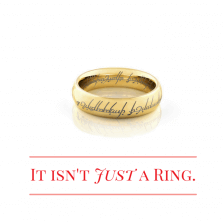The Best SAT Essay Ever
Objective Correlatives. Steamed fish. SAT essays. Ethan Sawyer, the College Essay Guy, explains how objective correlatives, such as steamed fish, can help you write the best SAT essay ever.
Six years ago, a student in my class, Joseph Tsai, wrote the greatest SAT essay ever. No joke.
I’ll share it with you in a minute, but before I do, let me set it up:
The Objective Correlative
T.S. Eliot claimed the only way to express emotion in art is through the use of an objective correlative. What’s that, you ask?
It’s an OBJECT that you CORRELATE to certain emotions.
Okay, that’s not much help. Here are a couple quick examples:
1. The One Ring in Lord of the Rings
Think about it: it’s not just a ring. It also represents greed and power, how power can corrupt, and how power can help you do awesome things like turn invisible and sneak past Gollum, for example.
2. The wilting enchanted rose in Beauty and the Beast
But it’s not just a flower, right? It represents the selfishness that got the dude turned into a beast in the first place. Plus, it’s a ticking clock: when the last petal falls off … well, I won’t spoil it for the three of you who haven’t seen the film.
3. The snow globe in Unfaithful
This film, co-penned by Oscar-winning screenwriter Alvin Sargent, has the most complex and clear use of an objective correlative I have ever seen in film. But note that this film is Rated M for Mature. Just sayin’.
How can you use an objective correlative to make a reader feel things?
Step 1: Program the object with qualities and emotions.
What do I mean by “program”? When you introduce the object, associate it with several emotions or values.
Example: Early in the film Toy Story we see that Andy, Woody’s owner, has written his name in big letters on the bottom of Woody’s shoe. This image—“ANDY” scrawled in kid handwriting on the bottom of Woody’s shoe—represents all the love, happiness, and friendship that connect Woody and Andy, all of which are established during the opening “You’ve Got a Friend in Me” montage.
Once you have associated your object with emotions and values, you will have turned that simple object into a complex objective correlative that you can do stuff with.
What kind of stuff? Like making the reader or viewer FEEL all sorts of things.
How do you do this?
Step 2: Show the objective correlative in a new context
In Toy Story, once Buzz Lightyear enters the scene and Woody is demoted to Toy #2, the filmmakers need only show Woody looking at “ANDY” scrawled on the bottom of Woody’s shoe to let us know that Woody is now sad. But not just sad. Jealous, angry, and perhaps even this complex cocktail of emotions that can’t quite be put into words. (But it can be put into an object!)
What’s great about this technique? At least three things:
i. By simply showing the object, the writer allows room for the viewer or reader to project his or her own feelings into the experience. In the Toy Story example, for instance, when we see Woody looking at “ANDY” scrawled on the bottom of his shoe and we know Woody is no longer Andy’s #1 toy, we’re reminded of the time we felt replaced or forgotten. (And all the writer had to do was show Woody looking at his shoe! Amazing.) Why else is this great?
ii. This draws us more deeply into the story because now we’re feeling with Woody. (Sorry, that sounds weird.) And finally,
iii. It shows us the character has grown or changed. (You will see this in the example below.)
Okay, so.
Here’s how all this can help you write an amazing SAT essay.
First, read my favorite SAT essay ever, which I call the “grandma’s steamed fish” essay. Then we will talk about the writer’s use of the objective correlative.
Fun fact: this student had no idea what an “objective correlative” was and didn’t know he was employing these principles. He was, as he told me later, “just trying to write a good essay.”
The Prompt:
“I wonder if we’re not breeding a society that lacks self-esteem. I don’t think we pat people on the back enough, letting them know that being able to fix a sink is just as much skill as being able to score a touchdown or hit a home run. And more worthwhile, if you were to ask me. People must be made to feel their value.”
Adapted from Bill Lee
Assignment: Should we give people more praise in order to build up their self-esteem? Write an essay that explains your views on this issue. Be sure to support your position with logical reasons and examples. You may use examples from history, contemporary events, art, science, literature, or personal experience and observation.
The Essay, by Joseph Tsai:
“My grandma makes the best steamed fish. She garnishes a fresh fish with ginger, fresh green onions, and a special delicious black sauce. Every time my family and I go out to Monterey Park to visit her, she has two steaming plates of tasty, tender fish waiting for us.
It has truly become one of our family traditions. That is, until my grandpa passed away this April. My grandparents were inseparable. My grandpa took care of my grandma when he still had strength, and my grandma watched over my grandpa after he had become weak. She perfected the art of creating succulent dishes that were easy to chew and swallow—tofu, steamed egg whites, preserved vegetable porridge, and others.
However, upon my grandpa’s passing, my grandma became an entirely different person. She entered a melancholy state of depression which lasted for weeks. We often visited her to try to comfort her, but those steaming plates of fish no longer awaited us. She would no longer leave her house to play mah-jongg with her friends. She began to sleep on my grandpa’s side of the bed. When we went out to eat, she would usually just sit silently, only speaking when spoken to, answering with responses as short as possible.
Then one day when we were at Monterey Park, my dad brought back live crabs. We cooked them and began to eat them, but decided the crab meat would be better with some sauce. My mom mixed some soy sauce with chili sauce and brought it back to the table. My grandma tasted it, and without a word, took the sauce back to the kitchen. I heard furious chopping for half a minute and she came back with the sauce which looked entirely different. She added minced garlic, some chopped basil, hot peppers, and sesame oil. It blended perfectly with the crab. We all praised my grandma and soon the sauce was all gone. She smiled, went to the kitchen, and came back a few minutes later with more sauce. Soon, we finished all the crab at a record-breaking pace, and flooded my grandma with more compliments. Afterwards, I went out to play basketball at a local park with my brother. After a couple hours of playing, we headed back exhausted. As I walked in, I could make out the unmistakable aroma of my grandma’s fish.”
But the million dollar question is:
How can this help you write an amazing essay, either for the SAT or your personal statement for college?
Click here to view a PDF of the essay with all my notes and analysis, including 10 tips for using objective correlatives in your own writing.
About the Author
Ethan Sawyer has been helping students tell their stories for more than ten years and is the author of the Amazon bestseller College Essay Essentials, the #1 book on college essays. He has reached thousands of students and counselors through his webinars and workshops and has become a nationally recognized college essay expert and sought-after speaker. He is a graduate of Northwestern University, received an MFA from UC–Irvine, and is an active member of NACAC, WACAC, SACAC, OACAC, HECA and IECA (feel free to Google those) and lives with his wife and daughter in Los Angeles. For more information, visit www.collegeessayguy.com.
Essay image courtesy of Shutterstock.
Lord of the Rings image courtesy of Shutterstock.
Blue Rose Under Glass image courtesy of Shutterstock.
Steamed Fish image courtesy of Shutterstock.
Ethan Sawyer has been helping students tell their stories for more than ten years and is the author of the Amazon bestseller College Essay Essentials, the #1 book on college essays. He has reached thousands of students and counselors through his webinars and workshops and has become a nationally recognized college essay expert and sought-after speaker. He is a graduate of Northwestern University, received an MFA from UC–Irvine, and is an active member of NACAC, WACAC, SACAC, OACAC, HECA and IECA (feel free to Google those) and lives with his wife and daughter in Los Angeles. For more information, visit www.collegeessayguy.com.









